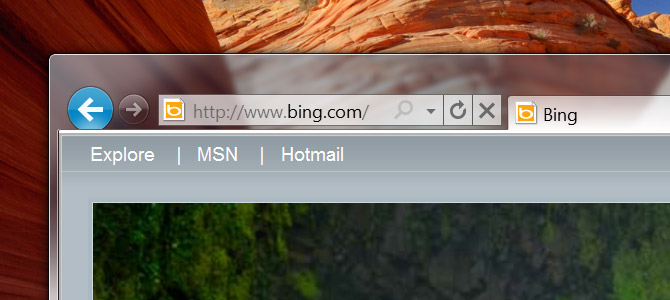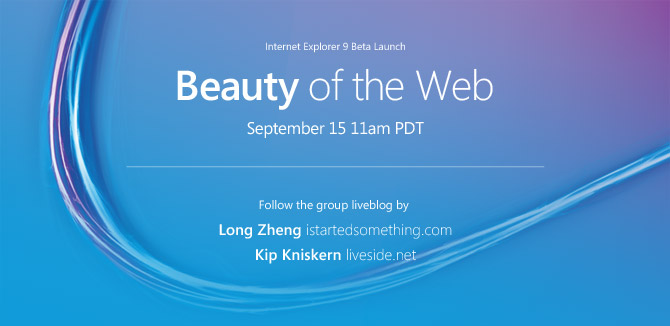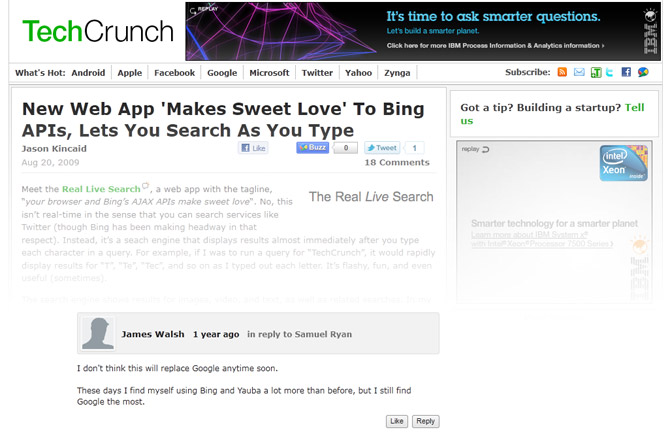For those who missed the live webcast of the keynote or am interested in the other happenings here at the Internet Explorer 9 “Beauty of the Web” launch event here at the San Francisco Design Center, here’s a few photos from the small gathering of press, partners and Softies around the browser of the hour.
Monthly Archives: September 2010
Behind the design of the Internet Explorer 9 chrome

After the “Beauty of the Web” keynote earlier today I got a chance to speak with several design leads of the Internet Explorer 9 team – Mary-Lynne Williams, Jane Kim and Jess Hollbrook to learn more about the decisions made to make one of the most designed Internet Explorer releases for a long time.
The first thing you’ll notice with IE9 is that just how “light” it looks. Even though the IE9 chrome takes up less screen real estate than both Chrome and Firefox 4, it was actually not a goal of the team to build the smallest chrome. A fundamental concept of the new approach to Internet Explorer’s design is that “it is not about the pixel count, but what you do with it”.
Whilst the team doesn’t claim their single-line design as the solution to the tabs-over-address bar dilemma, it was decided after all the two-line configuration was too distracting for users. The team also determined the window’s title bar was redundant because the name of the page was already displayed in the tab.
To further reduce the number of concepts in the chrome, the address bar was merged with the search bar after statistics showed that people used both bars just as much to search. They found that the new OneBox is not just simpler but actually helps people feel like they’ve mastered the functionality of the browser and gives them more confidence to just search without thinking about which field to search in.
Due to the one-line configuration, determining the size of the OneBox was no easy feat. To scientifically optimize the default size, researchers went out to find the top 2000 domain names and made sure that most of them could be displayed without truncation. Subtly, the OneBox also adapts its size proportionally to the screen resolution to fit approximately a third of the width for greater than 1024px and half the width for 1024px or smaller.
An obvious question people have asked ever since the UI leaked out a month ago is that how the browser deals with many tabs. Not surprisingly there is a power-user perception that everyone runs with dozens of tabs but as the design team found out via telemetry that it is simply not true.
For 90% of the browsing sessions they analyzed, most people had 4 or fewer tabs open and never more than 8. As such, on a reasonbly sized display, there is more than sufficient room for tabs used by most users.
Although the performance and standards capabilities of Internet Explorer 9 exceeds the competition today, even Microsoft acknowledges that they might not be in the lead for very long. However, the new user-experience seems to have enough merit on its own to differentiate IE9 as not just another release with better standards support. This is actually pretty neat.
Liveblog: Microsoft’s “Beauty of the Web” Internet Explorer 9 beta launch
Today will officially be known as the day Internet Explorer fought back. Join Kip (LiveSide) and I as we bring you all the thrills and spills from the “Beauty of the Web” keynote at the San Francisco Design Center.
You can find the live webcast stream on the Microsoft site here but we invite you to follow along our liveblog with reader comments for extra commentary goodness.
Mark your calendars: Microsoft’s “Beauty of the Web” Internet Explorer 9 beta launch group liveblog

They say beauty is in the eye of the beholder which is one reason you’ll want to pay attention to Microsoft’s Internet Explorer 9 “Beauty of the Web” event next week.
Join Kip Kniskern from LiveSide and I in another always-entertaining group liveblog of the keynote where Microsoft’s expected to launch a beta version of the browser in all its glory with an emphasis on design if all the marketing materials are to be believed. The venue, the San Francisco Design Center, probably has some relevance too.
The keynote is expected to start Wednesday, September 15 11am US Pacific Daylight Time (check your local times here). Alternatively, download the iCal I prepared earlier for convenient calendaring.
According to Microsoft “beautiful is feeling the love”, so bring on the love I say.
Microsoft Australia launches SCREENed student film competition: 7 minutes about “7”
The number seven seems to have found a good home at Microsoft; Windows 7, Windows Phone 7 and now even a student film festival dedicated to it called SCREENed.
Although I won’t even pretend to know how the video above is in any way related (but it looks fun), Microsoft Australia wants Aussie students to make a short movie about anything “7” in under 7 minutes.
The competition, open to all Australian-enrolled university, college or TAFE students invites anyone remotely interested in film of any style or genre to make a movie, as long as it incorporates the theme and be not over the time restriction.
Like any good Microsoft competition, there’s some good prizes. Among the three possible awards, the best use of theme win an ultimate entertainments and PC pack including two Windows 7 laptops, three XBOX 360 Elites, three copies of Windows 7 and three Windows Phone 7 handsets.
The competition closes 25 October 2010. Look forward to what crazy ideas people come up with.
Real Live Search: where was Bing 12 months ago? (update: Bing has HTML5 update up their sleeves)

For nostalgic reasons, I decided to revisit TechCrunch’s article on my Real Live Search experiment more than a year ago. One comment in particular amused me with what is possibly the very definition of irony in retrospect.
In all seriousness, someone today raised a very good question, why didn’t Bing implement this much earlier when it was clearly demonstrated how even their public developer APIs could have quite easily supported the functionality and load. In fact the only missing component was some Javascript which took all of a night for me to implement a prototype.
Unfortunately for Bing, I think this was a missed opportunity that will now only end up with them being labelled “copy cats” when it does eventually ship.
Update: Christo27 in the comments below shared this video of a Bing session at the Apple WWDC 2010 event earlier this year. Apparently they showed off a demo of a prototype HTML5 version of Bing that has some interesting functionality including but limited to a quasi-instant version of the search results page.
It looks pretty sweet and maybe this is why Bing has been holding off any updates. After all, Internet Explorer 9 will ship with HTML5 support.